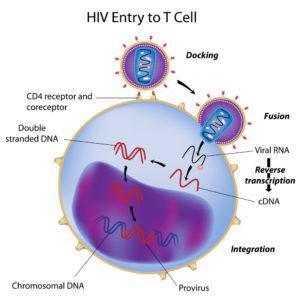
HIV entry into T cell (http://www.interactive-biology.com/3574/aids-and-mechanism-of-hiv-infection/)
Acute HIV infection is characterised by high viremia and CD4 T cell depletion. Anti-retroviral therapy (ART) greatly reduces viremia and prevents further CD4 T cell depletion. If ART is stopped, viral rebound in HIV+ individuals with undetectable viral loads is often observed. This viral rebound has been attributed to replication of the CD4 T cell viral reservoir (HIV genome integrated into the CD4 T cell DNA).
T cells are very heterogeneous, consisting of naïve T cells and 5 memory T cells populations: stem cell (TSCM), central (TCM), transitional (TTM), effector (TE) and terminal effector (TEM). Knowledge of viral reservoir is predominantly from research conducted during chronic HIV infection. Based on such research TSCM and TCM T cells are considered to play a major role in long-term maintenance of the viral reservoir. However, research of the viral reservoir during acute phase of HIV infection is limited. As a result, cross continental research (Africa, Asia, Europe and N. America) aimed to expand on this knowledge by examining T cell memory kinetics during acute phase of HIV infection.
Research on a cohort of recently infected HIV+ individuals, showed that total TSCM and TCM cells increase during the acute phase, and follow similar kinetics as the viral load. High TSCM and TCM populations was not attributed to superior proliferative potential of these phenotypes. However, they did not show viral integration in direct ex-vivo CD4 T cells from these individuals. Instead they used an in vitro model, where PBMCs were infected with HIV viral to show that TTM, TE and TEM are preferentially infected by HIV and harbor increased viral integration compared to TSCM and TCM populations. They conducted additional experiments, that suggested that high TSCM expansion is associated with high viral load. Specifically individuals that have high viral replication in the TSCM phenotype, also have viral replication of effector cells. These results are very interesting and would require a larger data set to be validated, as well as determine if this TSCM viral reservoir is maintain throughout the acute phase and are the precursors for the viral reservoir in during chronic infection.
Journal Article: Pušnik et al., 2019. Expansion of Stem Cell-Like CD4+ Memory T Cells during Acute HIV-1 Infection Is Linked to Rapid Disease Progression. JVI










